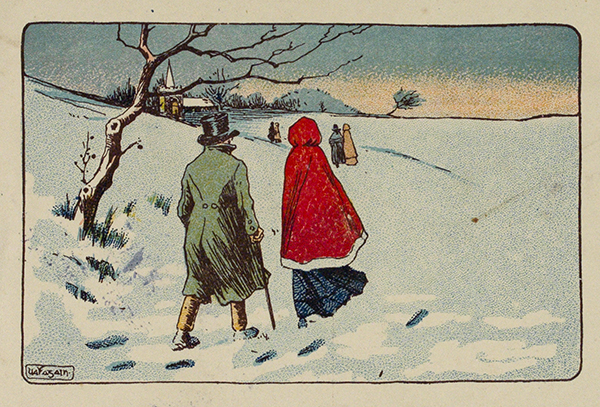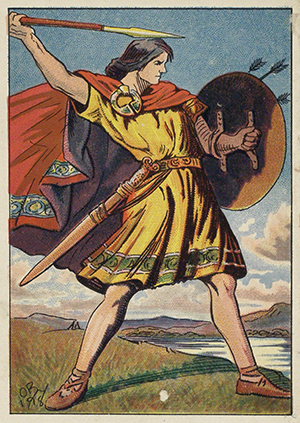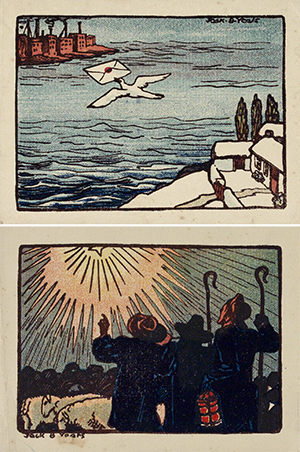Greeting the nation—the Irish Christmas card
Published in 18th-19th Century Social Perspectives, 20th Century Social Perspectives, Features, Issue 6 (November/December 2016), Volume 24THE INTERSECTION OF CHRISTMAS SENTIMENT, NATIONAL IDENTITY AND AESTHETIC TASTE IN EARLY TWENTIETH-CENTURY IRELAND
By Teresa Breathnach
Just before Christmas 1916 Countess Markievicz realised that, with the advent of world war, the festive cards that had been made in Germany had simply been replaced by those made in England. She immediately set about designing a series of ‘Irish’ cards for that holiday season. As Margaret Skinnider recalls in her memoir, however, ‘… when that Christmas came around she was in prison and the cards were—no one can say where’.
One cannot help but wonder what the countess might have included in her designs. Was it enough that they would be designed and produced in Ireland? Or would her designs depict a particularly Irish Christmas, distinctly different from their German and English counterparts? The countess’s cards remain elusive, but a series printed by the Gaelic Press and now in the collections of the National Museum of Ireland give us some insight into the intersection of Christmas sentiment, national identity and aesthetic taste in early twentieth-century Ireland.
Stanley’s Gaelic Press and Walker’s Tower Press
These cards were published between 1913 and about 1918 and reproduce the work of different artists, most notably George Fagan and Jack B. Yeats. The Gaelic Press was owned by Joe Stanley, well known in nationalist circles in the 1910s. Printing mainly items of nationalist ephemera, the press was in frequent trouble with the censor and had its premises raided regularly on suspicion of printing seditious literature. An astute businessman as well as an idealistic nationalist, Stanley must have recognised the operational and commercial potential of a print works catering for the nationalist community when he purchased his father-in-law Matthew Walker’s Tower Press in 1913.
Matthew Walker’s own career spans what has become known as ‘the long gestation’ of Irish nationalism. Known as the ‘Parnellite printer’, he was most publicly associated with the establishment of The Carlow Vindicator and Leinster Standard, a mouthpiece for Parnell, in the early 1890s. After the failure of the newspaper, he worked as a compositor and Linotype operator in Dublin, opening a tobacconist’s shop in High Street near Christ Church Cathedral and later establishing the Tower Press close by. The Tower Press became one of the print works most linked to the production of nationalist material in Dublin in the early 1900s, and was associated with the IRB, the Abbey Theatre, Inghinidhe na hÉireann’s radical periodical Bean na hÉireann and Francis Sheehy Skeffington’s National Democrat. It is perhaps best known for the production of an early series of works for Maunsel & Co. called the ‘Tower Press Series’.
Some of the imagery on the cards can be dated clearly to the Gaelic Press period; others may have reproduced images used earlier in the century by Walker. It’s easy to imagine Markievicz producing similar images of marching Volunteers or Fianna Éireann, Celtic warriors or tricolours in late 1916. The depiction of the tricolour only became more commonplace after the 1916 Rising, while images of Volunteers and Fianna Éireann could not have been produced prior to 1913 or 1909 respectively. It seems likely, however, that the images by Yeats and Fagan in this collection were both reproduced by the Gaelic Press after 1916 and used originally by Walker a decade earlier. Indeed, Maire Nic Shubhlaigh (Mary Walker), Matthew’s daughter and a well-known Abbey actress, remembered that ‘we were the first publishers of Christmas cards in Ireland with Irish inscriptions’.
The cards were printed lithographically on inexpensive paper. Yeats’s images of men on horseback and with a pony and trap recall his series of illustrations of the west of Ireland published in the early years of the century. Fagan’s images must also have been produced before 1907, when the young artist died prematurely. Like the cards that feature Yeats’s visions of the West, those showing Fagan’s hurler and Gaelic footballer might have been reused for any occasion by simply reprinting the original plate and altering the accompanying motto. The artists’ other illustrations evoke a specifically seasonal message that draws on an established Christmas idiom: Yeats’s bird in flight over a snowy landscape, his shepherds with Christmas star and Fagan’s couple on their way to Mass across wintery fields.

Above: George Fagan’s image of a couple making their way across snow-covered fields to a small chapel is lent its Irishness by the content and look of the associated greeting in Irish and English. (NMI)
Whether Walker was actually the first to print cards in Irish is open to question, but it seems likely that they were at least amongst the earliest. Joseph Holloway, the Abbey architect, refers to Fagan’s being remembered at an ‘at home’ at the Walkers, when ‘Mr Walker brought down and showed George Fagan’s sketch book … M. Walker got him to draw some Christmas cards which he reproduced afterwards’. Interestingly, there was also an ongoing relationship between the Walker and Yeats families throughout this period: not only did Maire act under W.B. Yeats at the Abbey, but she also worked briefly for his sisters’ Dún Emer embroidery workshop and, according to family memory, became an object of infatuation for his father. Indeed, John B. Yeats’s portrait of her is well known and still hangs in the Abbey, and he also sketched Matthew, amongst others, at the Confederate Club in the 1880s. These connections are reflected in an address book of Jack B. Yeats, in which Walker’s address is updated regularly from the 1890s onwards. Maire’s recollection of her father’s Christmas cards is echoed in two advertisements placed in Irish-language journals. The first, published in November 1902, proclaimed the sale of ‘Cartai Nodlag I nGaedhilge Amháin’ (‘Christmas cards in Irish only’) from ‘M.S. Mac Siubhlaigh [M.J. Walker] Bookseller and Stationer’, going on to describe how the cards carried ‘new designs by a well-known Irish artist’, that they were lithographed in Dublin and were of Irish manufacture throughout. By November 1905, Walker seems to have extended the range of designs he was printing and the outlets where they might be purchased. He advertised in the National Democrat (which he printed for Francis Sheehy Skeffington) that ‘Irish Christmas cards, produced entirely in Dublin from designs by Miss E.C. Yeats, George Fagan and Jack B. Yeats … mottoes in English and Irish’, in ‘this season’s new designs’, were to be had from ‘all stationers or the publishers, M.S. Mac Siubhlaigh’. It is likely that this refers to the surviving designs by George Fagan and Jack B. Yeats in the Stanley Collection.

Above: Apart from the initials ‘O.R./O.B.’ the artist of this Celtic warrior is unidentified. While the image is not Christmas-related, the accompanying text includes a greeting in both English and Irish for a good Irish Christmas. A verse, attributed as a translation by Patrick Pearse, reads: ‘No man shall be bound unto England/Nor hold friendship with dour Scotchmen/There shall be no place in Ireland for outlanders/And no recognition for the English speech’. It may have been the content of this text rather than the image that led the press censor to mark the card ‘Not for Publication’. (NMI)
An Irish Christmas
As a modern nation, Ireland was as much a part of the commercialisation of Christmas as any other outpost of empire. Christmas was sold through a wide spectrum of goods and services, and greeting cards such as Walker’s were a part of what had become by then the spectacle of Christmas. Although cards often featured unrelated imagery, the symbols of Christmas were well established by this time—snow scenes, holly and ivy, feasting and Santa abounded in early twentieth-century Dublin.
McBirney and Co. advertised their ‘Grand Exhibition of Christmas Novelties. In the firm’s new windows during the week will be displayed a splendid collection of … toys, dolls and Christmas cards in great variety.’ Such a commercial evocation of Christmas also coincided with the emergence of a market for those goods perceived to be specifically Irish in terms of their materials, manufacture, style or function. The support of Irish manufacture became a badge of identity alongside the reading of Irish literature, the playing of Irish sport and the speaking of the Irish language. The same year that Walker first advertised his cards, the Gaelic League called for its members to ‘support home industries … support Irish manufacture particularly during the festive season when so much money leaves the country through the thoughtlessness of our people’. The Freeman’s Journal advertised their Christmas Annual, which included a feature on Irish dancing, and a Nativity play in Irish by Douglas Hyde and Lady Gregory. Manufacturers and retailers also recognised the monetary value of this market and promoted their goods to appeal to it.
Christmas had become a more Gaelic affair. In some cases, the value of a card being ‘Irish’ applied specifically to those being posted to foreign destinations. Many of these seem to evoke a regional Irish identity allied to empire, echoing the production of cards with Scottish or Welsh associations. Messrs Waller of Suffolk Street advertised ‘For sending abroad … Irish made cards containing packets of shamrock seed, with appropriate greeting from the “Old Country”.’ Dixons of St Stephen’s Green promoted cards ‘suitable for sending from Ireland to friends abroad’. The 1898 Christmas issue of The Lady’s Journal contained a special feature illustration by Miss McKay of Belfast, who had apparently already ‘introduced … Irish Christmas cards … the forerunners of her … various scenes from peasant life … all of which are racy of the soil’. The four-page feature, entitled ‘The Classes and the Masses’, shows portraits of society ladies juxtaposed with scenes of a contented peasantry engaged in non-threatening, semi-comic and picturesque behaviours. Alongside this are reproductions of the sort of imagery that made up the mainstay of Christmas card illustrations more generally and which continue to be familiar to us now: sentimental depictions of cherubim and small children in festive dress, for example.
Advertisements for Christmas cards in Irish-language periodicals, not surprisingly, emphasise the inclusion of a motto in Irish. Guy and Co. of Cork offered some which were relatively elaborate, ‘beautifully printed in gold and colours’, assuring their Irishness with ‘Irish ornaments, emblems and mottoes … the best Irish Christmas cards ever issued’. The grandly named Confederate Industrial Society advertised both ‘plain and coloured’ cards which were ‘Gaelic’ in their use of ‘Irish designs, Irish artists, Irish manufacture’. Somewhere between luxuriously printed offerings and the plainer variety, Eason’s produced Christmas cards as part of their ‘Irish Series’. An image and greeting printed in just one colour on inexpensive paper were augmented by a green ribbon. The use of green ink, shamrock and sunrise motifs, Celtic interlace and heraldic symbols of the four provinces underline this Gaelicness.
A less insular use of both art nouveau and arts-and-crafts style
Other variations of an Irish Christmas were visualised alongside these. The masthead of The Irish Homestead magazine’s special seasonal publication A Celtic Christmas uses lettering which drew partly on Gaelic manuscripts but is combined with a less insular use of both art nouveau and arts-and-crafts-style imagery, understood as being artistically and socially modern. Internally, the reproduction of illustrations by Jack B. Yeats referenced an authentic west of Ireland, but their bold outlines also suggest a very modern illustrative style. The Irish Homestead’s Christmas may well have been Celtic, but it could also be outward-looking, perhaps appealing to a separate set of Irish tastes than those represented by some of the more usual Christmas fare.

Above (Top): Jack B. Yeats’s image of a bird carrying a letter across the sea contrasts a snow-covered idealised Irish cottage with a dystopian industrialised conurbation on the far shore. (NMI)
———————————————————————–
Above: The shepherds’ wide-brimmed hats and the drystone wall in front of them recall many of Yeats’s other depictions of the West and place this holy scene firmly in the most authentic of Irelands. (NMI)
What sort of Irish Christmas was Walker imagining in his cards? Fagan’s couple make their way across snow-covered fields to a small chapel, the female figure wearing a long, red, hooded cloak trimmed in white, which had connotations of Santa Claus even then. There is no real indication that this is a specifically Irish scene. Rather it is lent this Irishness by the content and look of the associated verbal greeting. Yeats’s card featuring the image of the three shepherds is more striking in its evocation of Irishness. Both the wide-brimmed hats that the shepherds wear and the drystone wall in front of them recall many of Yeats’s other depictions of the West and place the holy scene firmly in the most authentic of Irelands. Yeats’s bird in flight travels across the sea, from a snow-covered cottage to an industrialised, urban conurbation on a far shore. The depiction of a snowy landscape and the theme of contact between family and friends were widely associated with the Christmas card by this stage, but this card interprets the theme in a specifically Irish way. The cottage is peculiarly Irish, with its white walls and red half-door. Such idealised images had already become associated with a cultural authenticity that was frequently contrasted with a dystopian image of industrialised modernity, as it is here. The use of Irish symbols for cards to be sent abroad was already an established practice. Yeats’s image may well be referencing this specifically, or perhaps is a more generalised acknowledgement of communication between Ireland and its emigrants. He employs a similar theme in the image for a hand-printed, hand-coloured card produced some time after 1908 as part of a series of Cuala Press Christmas cards. The Message depicts a drake flying above a traditional thatched cottage in a landscape of hills towards a distant sea. Despite differences in the quality of design and production between the two, there are striking similarities between them in terms of subject-matter, and, of course, style. Walker’s use of Yeats’s illustrations pre-dates that of the better-known, higher-quality Cuala Press cards.
If one were to place all of these evocations of an Irish Christmas on an imaginary line, one might position these hand-printed and coloured Cuala Press cards at one end, Eason’s Irish symbolism in the centre and Miss McKay’s happy peasantry at the far end. Walker’s cards might be most comfortable somewhere between Eason’s offerings and those of the later Cuala Press, perhaps recognising a thirst for a nascent but more aesthetically elevated Irishness.
Teresa Breathnach lectures in the history of visual and material culture in the National College of Art and Design, Dún Laoghaire Institute of Art, Design and Technology and the Dublin Institute of Technology.
FURTHER READING
K.L. Ames, American Christmas cards 1900–1960 (New York, 2011).
L. Godson & J. Bruck (eds), Making 1916: material and visual culture of the Easter Rising (Liverpool, 2015).
D. Kenny (ed.), The splendid years: the memoirs of an Abbey actress and 1916 rebel (Dublin, 2016).
H. Pyle, The different worlds of Jack B. Yeats: his cartoons and illustrations (Dublin, 1994).
















